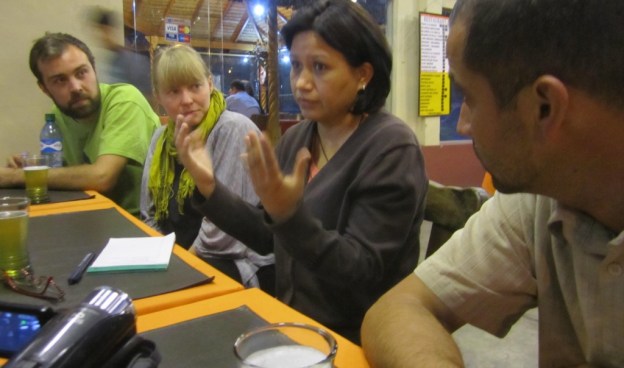
Cochabamba Our days in La Paz were never complete without a trip to or from El Alto, the city of a million on the top of the mountain, which made us acutely aware of the importance of this strategic location in the future of social movements and the very country. Meeting with Ivan Nogales, the director and 23-year veteran of Teatro Trono, he made the same point by beginning our visit with a sweeping historical look at the rebellion in 1789 where the poor at the top of the hill were able to encircle for a while the rich at the bottom of the mountain, and nearly starve them out. By analogy he felt that El Alto and his mutli-cultural centers headquartered in here with branches in a half-dozen other cities in Bolivia and one in Germany had created an artistic culture that was unique and powerful.
Ivan in many ways was arguing for a role for the artist in creating change by laying a foundation away from the rational mind, as he phrased it that could unite people and offer support to struggle in Bolivia, but also around South America. He was encouraged by meetings of cultural workers in several countries that were coming together to collaborate.
He told a story of several years ago taking a bunch of his team in an art truck of sorts and he showed us the model. They were headed for Rio on a trip of over 4000 kilometers with a truck that could not go over 70 kph or 50 mph or so. At the same time he tried to share the powerful welcomes they received from the mayor of Rio who met them when they arrived and gave them a key to the city. Clearly it had given Ivan hope for his operation. At the same time when asked about sources of support, he indicated that most of it came from Denmark and Finland, aid money on 2-year grants, and that he was going to have to lay off 80% of his staff next year. He said that was why he was down-scaling by trying to build a small compound in the countryside and hour and a half away. The operation was unique in its own way, and Ivan was inspired, but there were hurdles in the way of his vision.
Arriving in Cochabamba, we realized how sui generis La Paz and El Alto were in some ways. Cochabamba seemed more like other large Latin American cities. Indigenous people were less ubiquitous. There were trees. We could breathe the air.

Marcela Olivera, the Latin American coordinator of Red Vida (the Water Network) and a staff member for Food and Water Watch in Washington, DC, a long time ally of ACORN’s, gave us a briefing on the growth of the city, essentially having doubled to a million people over the last 25 years due to in-migration of miners and others from the countryside. At the core of the city’s challenges has been the inability of the infrastructure to keep up with that growth, leaving one set of services in the northern, richer part of the city, and a very rough world lacking even basic services like water in the southern part of Cochabamba. Marcela was candid about tensions in the city around some of the new governmental requirements, which might seem well meaning, but were alienating both traditional peoples and practices and middle class citizens with other concerns. At the same time Evo Morales, the Bolivian President, had been one of those migrants into Cochabamba, leaving many with a feeling of pride at a native son, even as they were skeptical about some of the current directions of the government.

Inevitably the conversation drifted to the unique vibrancy that social movements have had in Bolivia at different times. Marcela compared it to a year or two she lived in Washington, D.C., and her surprise that when an increase in the subway fares was announced she had gone underground gingerly, sure that there was bound to be a massive protest, “just like in her country,” and was still incredulous that there had been nothing of note. She worried that social movements were atrophying now under the Morales administration, either co-opted or confused that their friend could have changed so much.
Those of us living in the United States understood exactly what she was talking about!
